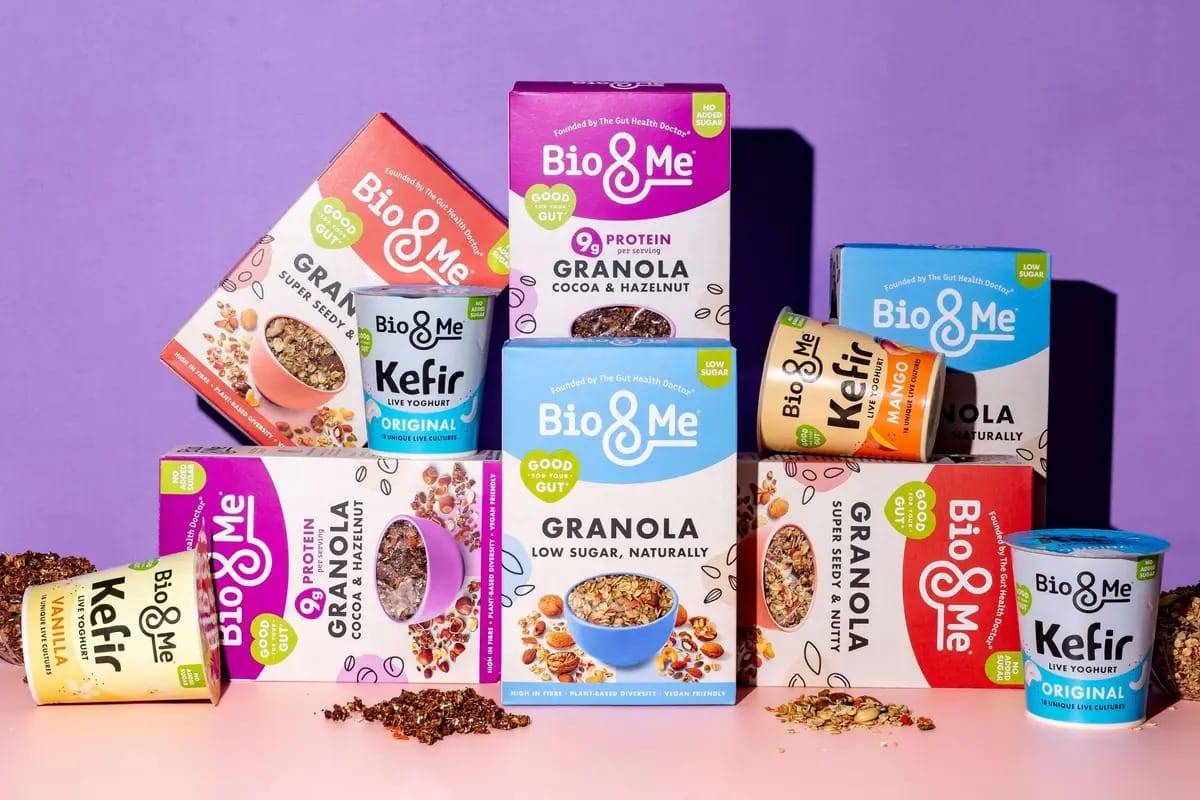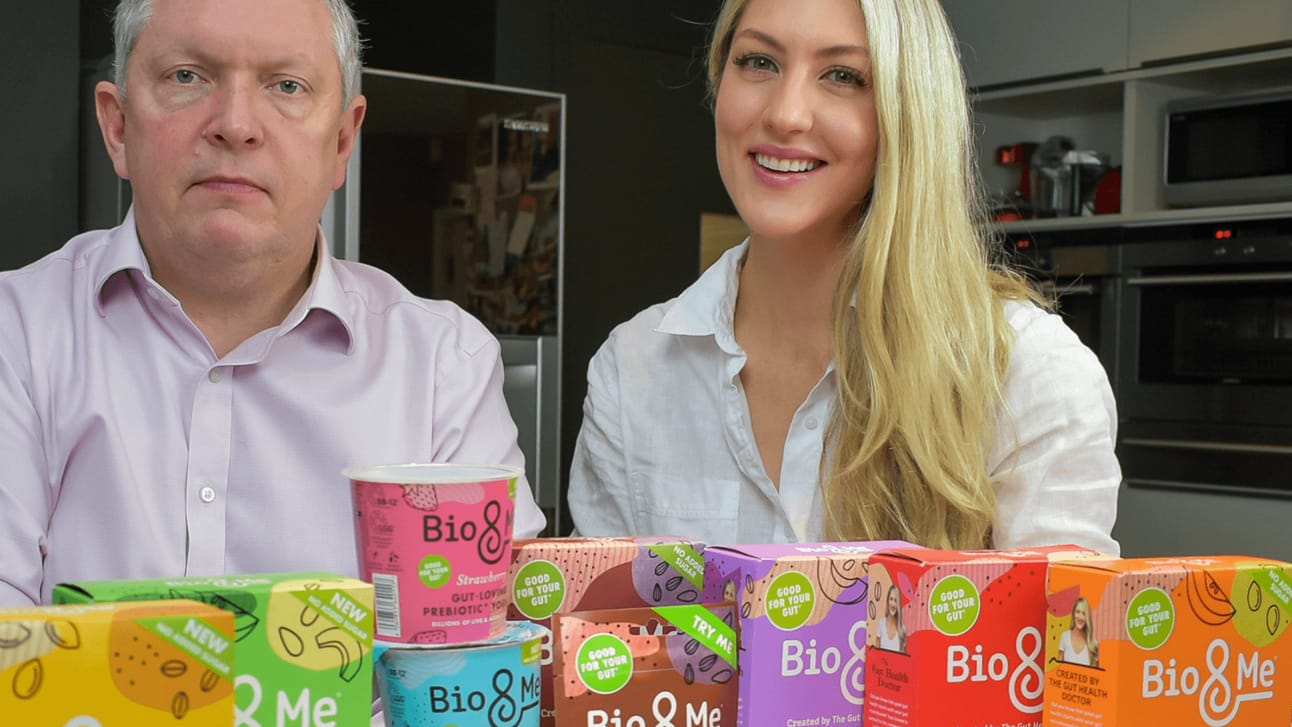- Conscious Commerce
- Posts
- 🟣 Issue No. 60: Bio&Me
🟣 Issue No. 60: Bio&Me
A gut health food brand backed by science, retail savvy, and loyal fans.


wellness commerce insights
$100M BRAND STORY
Bio&Me: Science Backed Snacking, Built for the Gut

When Dr. Megan Rossi and Jon Walsh launched Bio&Me in late 2019, they weren’t trying to surf the gut health trend—they were determined to ground it. Rossi, a clinical dietitian and research fellow at King’s College London, was frustrated by the gap between microbiome science and supermarket shelves. When big food companies asked her to be the face of their wellness SKUs without changing the formulas, she declined. Bio&Me was born to do better: no sugar bombs, no gut health theater, just evidence-based nutrition made delicious.
And it’s working. In 2021, they tripled sales to over £3M. In 2022, they raised £1.6M in just 72 hours. Among the backers: England captain Harry Kane.
Are They Funded or Bootstrapped?
Bio&Me started lean, running close to break-even, using early sales to reinvest in growth. But as traction grew, so did opportunity. Listings at Waitrose, Planet Organic, Whole Foods, and Booths unlocked a funding round backed by four angel investors with CPG chops. That £1.6M raise in March 2022 added not only capital but cultural clout when Harry Kane joined the cap table.
Notably, this wasn’t cash-burned growth. Jon Walsh noted the brand had “doubled year over year” without overspending. They’ve kept marketing budgets tight, relying on retail excellence and Megan’s social credibility to build awareness.
Their Origin Story

Megan Rossi’s frustration fueled the idea. After years researching the gut microbiome, she realized no retail product embodied what science actually said. She turned down partnerships with large CPGs when they refused to reformulate, then teamed up with Jon Walsh, a veteran of Nestlé, John West, and P&G.
Together, they launched Bio&Me with a simple brief: design products that reflect real gut health science (like the 30-plant-per-week diversity model), use EFSA-backed prebiotic claims, and deliver superior taste. Rossi handled science and formulation; Walsh brought operational rigor. They took granola, a familiar format, and reengineered it with 15+ whole plant ingredients per box.
Core Customer Base
Bio&Me’s core customer isn’t defined by age or income. It’s a psychographic tribe:
Health-literate, science-seeking shoppers
Mostly female (30–50), with families or wellness routines
Follow Megan on Instagram and treat her like a trusted advisor
Buy in retail first, but engage directly via DMs, email, and social polls
These customers aren’t looking for fads. They want foods that earn their health claims and taste great doing it.
How Did They Grow So Sustainably? (P&L View)
Bio&Me scaled without performance marketing blitzes or subscription hacks. Their three-part growth flywheel:
Retail as a Brand Builder: They pursued prestige listings first—Waitrose, Booths, Planet Organic—to build credibility, not just sales.
Megan’s Media Engine: With 400K+ Instagram followers and mainstream visibility (books, TV, podcast appearances), Megan became the “media moat.”
Pack-First CAC: Products convert on-shelf because the packaging carries the science—15 plants, gut-friendly, certified prebiotics—all front-and-center.
They doubled annual revenue with minimal paid media. As Megan put it, “If we threw money at marketing, we’d grow faster but we’ve grown smart.”
Key Milestones
April 2019: Concept developed
July 2019: Brand name finalized
November 2019: Launch via Booths, Planet Organic, Whole Foods
2021: Triples revenue to £3M+, fastest-growing cereal brand
2022: £1.6M raise closes in 72 hours, Harry Kane joins investor group
2023: Yogurt range expands, DTC insights fuel retail tweaks
Influencer Marketing Mix
Rather than leaning on micro-influencer campaigns, Bio&Me scaled using one key influencer: their co-founder. Megan Rossi, aka The Gut Health Doctor, built her audience via science-based content years before launching products.
The brand’s influence mix includes:
Organic sharing by wellness professionals
Megan’s earned media and book tours
A hyper-engaged Instagram community that fuels NPD via story polls
This creator-founder model means Bio&Me has never needed aggressive paid amplification.
Their Marketing X-Factor
Bio&Me doesn’t scream “gut health.” It quietly proves it. Their pack design leads with simplicity and science. On social, they bust myths and teach without shaming. In retail, their storytelling does the work of a salesperson.
What makes them stand out:
Use of EFSA-approved claims (rare in the category)
Founder-as-educator model
Co-creation loops with customers
Their marketing is a flywheel: education builds trust → trust drives trial → trial drives feedback → feedback drives product improvement.
Takeaways for Wellness Operators
Science Converts When It’s Personal: Rossi’s credibility bridges clinical claims and consumer trust. Use founder stories to make data digestible.
Charming Persistence Wins Retailers: Bio&Me didn’t spray and pray. They followed up consistently, built warm intros, and became the fun part of a buyer’s inbox.
Grow the Long Way to Grow the Right Way: Sustainable growth isn’t slow—it’s smart. Reinvest wisely, build community early, and optimize for trust, not just ROAS.
Design Packaging Like a Paid Ad: Every Bio&Me SKU is optimized for shelf conversion. Treat your pack like a landing page.
Build a Media Engine You Own: Megan’s audience is a moat. Create founder-led content that educates and compounds over time.

ADVERTISE WITH US
Interested in advertising?
Connect with our highly engaged community of Wellness Commerce operators and execs.
How did you like today's newsletter? |